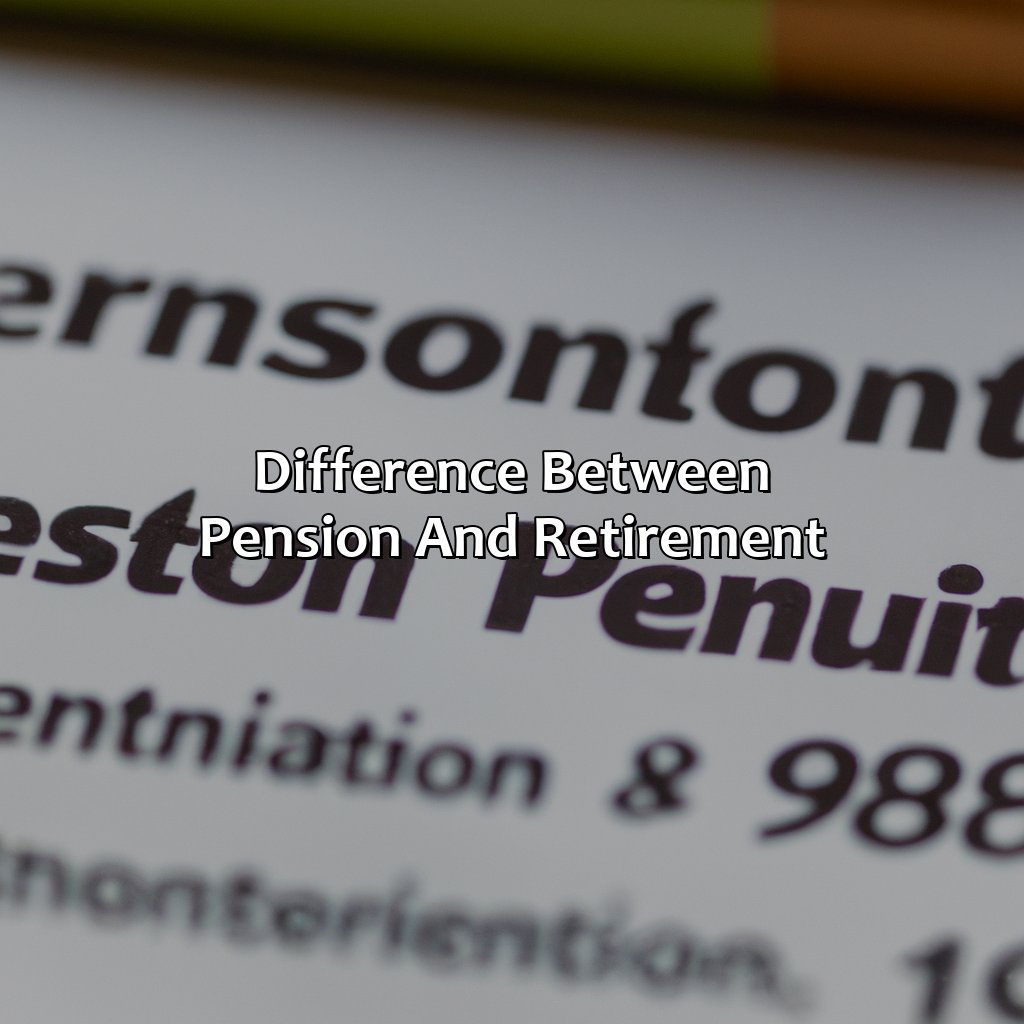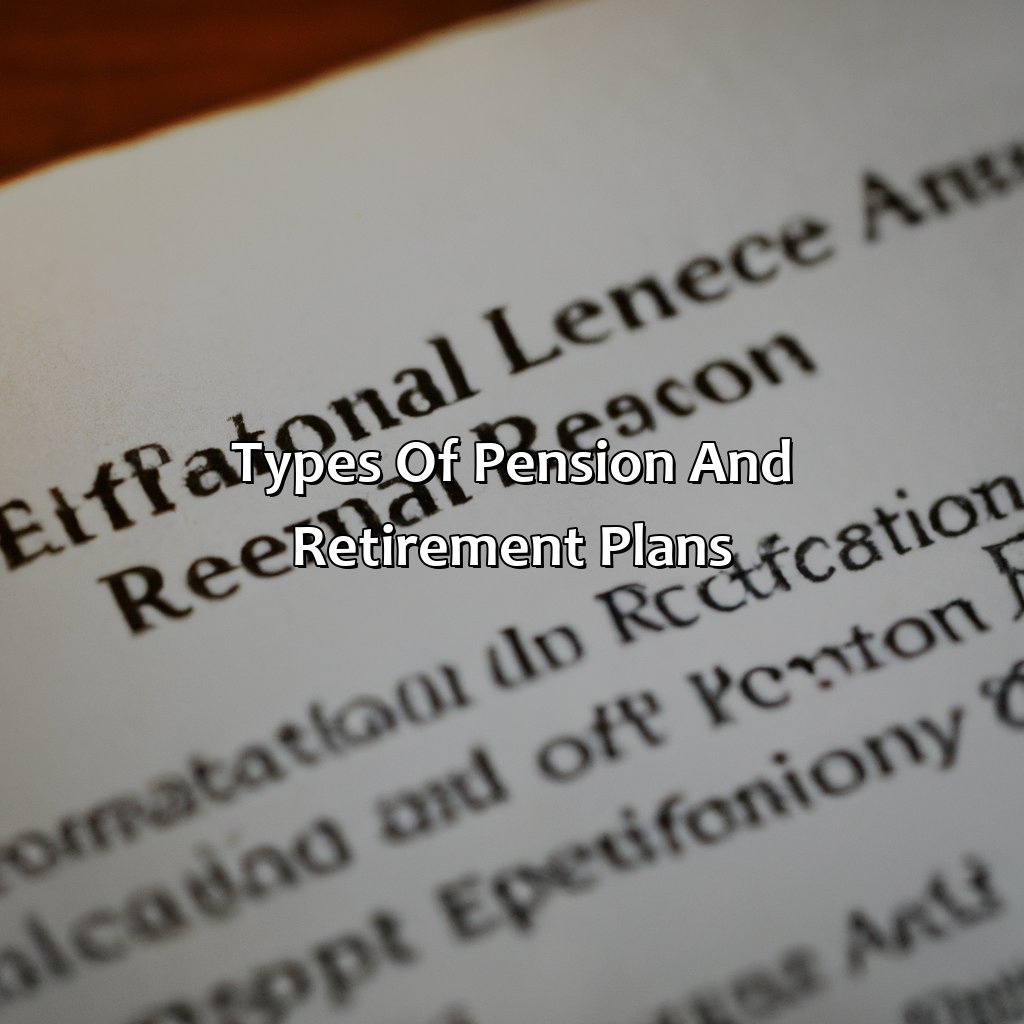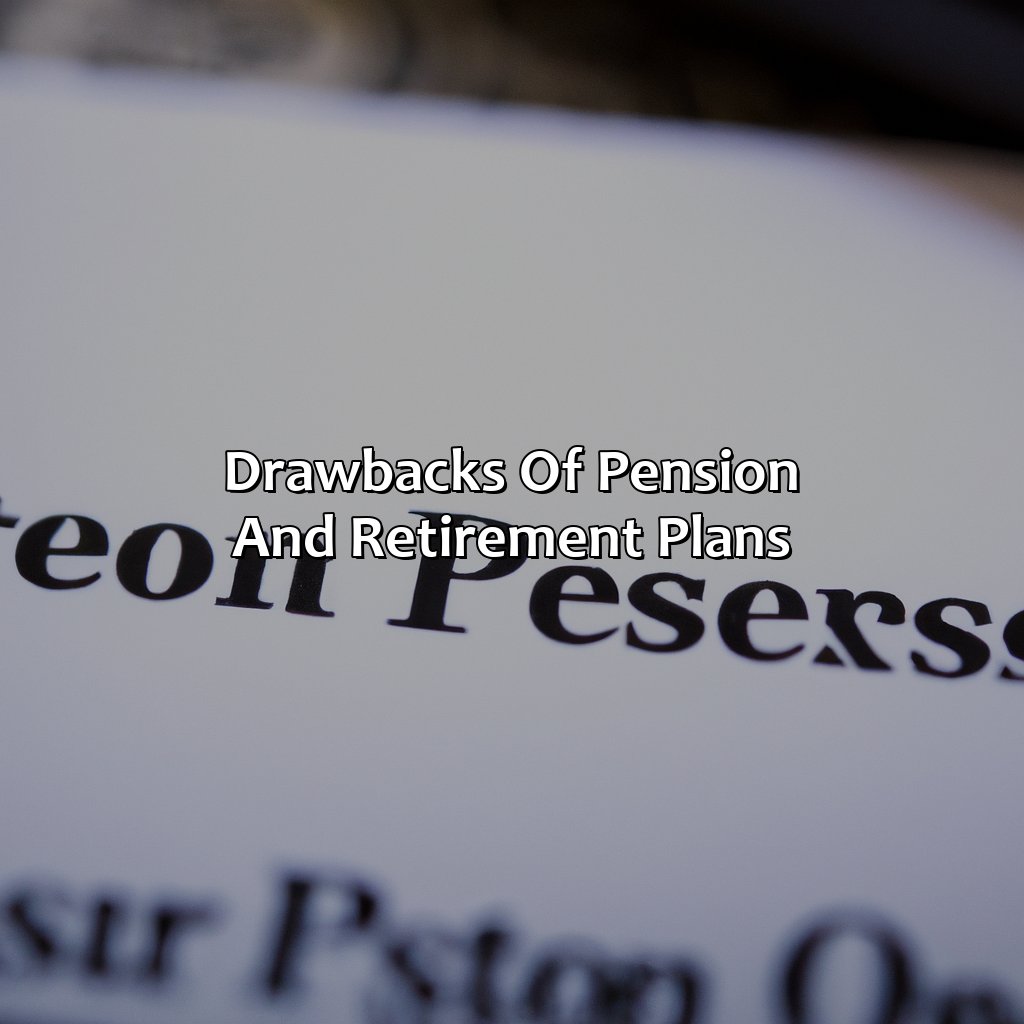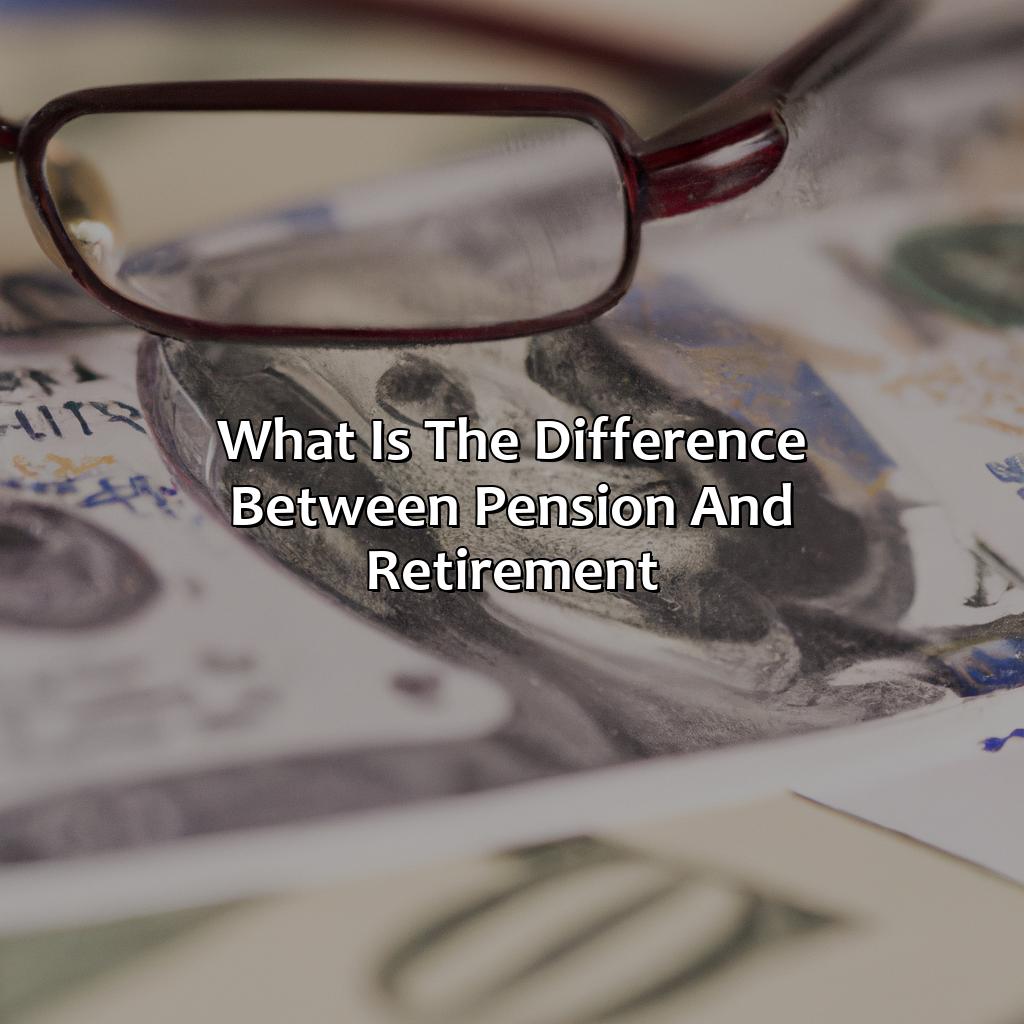What Is The Difference Between Pension And Retirement?
Key Takeaway:
- Pension and retirement are different concepts that often get confused. Retirement refers to leaving a career or work life, while pension refers to a specific retirement plan that may provide a guaranteed income stream in retirement.
- There are various types of pension and retirement plans, including defined benefit and defined contribution pension plans, government pension plans, individual retirement accounts (IRAs), and employer-sponsored retirement plans. Each type has unique features and benefits.
- The benefits of pension and retirement plans include financial security, potential tax benefits, and employer contributions. However, there are drawbacks, including limited accessibility to funds and potential risks.
Have you ever felt confused about the difference between pension and retirement? You’re not alone! This article will discuss the key distinctions between these two terms so you can make the most of your plans for the future.
Difference between Pension and Retirement
Unravil the difference between pension and retirement, you must define them both. Let’s outline the definitions of each. With this info, you’ll have a sound understanding of these major financial ideas.

Image credits: retiregenz.com by Harry Woodhock
Definition of Pension
Pensions provide income to retirees and are a crucial part of retirement planning. They come in various forms, such as defined benefit and defined contribution plans, and may be funded by the employer, employee, or both. Pensions offer a reliable and predictable source of income during retirement, which is especially important as people are living longer today.
Retirement planning encompasses the various financial strategies and steps one takes to ensure financial independence after leaving work. It’s an active process that begins early in one’s career when they start saving for their future needs. Retirement planning includes identifying income sources, creating a budget, managing assets, and making informed decisions about benefit options.
Individuals should consider developing a retirement plan early in their career as it can help them achieve their desired lifestyle during the golden years. A comprehensive strategy will include factors such as diversification across asset classes, contributions to retirement accounts (like 401(k)s), and managing taxes.
Pro Tip: Seeking professional advice from a financial planner or consulting industry-backed peer-reviewed publications may improve chances of success in pension-based retirement planning.
Retirement: when you trade in your work stress for the stress of figuring out what to do with all your free time.
Definition of Retirement
Retirement refers to the withdrawal or withdrawal from active working life. It is a stage of life where an individual stops working and depends on retirement savings or pension benefits. Retirement can occur at any age, but it typically occurs around the age of 65.
During retirement, an individual can enjoy the fruits of their labor and relax without worrying about work-related stress. In contrast to traditional employment, retirement involves no work-related activities or responsibilities. Instead, retirees have ample time for other pursuits such as hobbies, travel, relaxation or spending quality time with family and friends.
Unlike pension benefits that are provided by employers as part of a compensation package agreed upon at the onset of employment, retirement can be self-funded through personal savings. It is important to note that people need to prepare for retirement financially by saving up enough money over the course of several years in advance of entering into this phase of life. Many investment companies offer various instruments designed specifically for this purpose.
In ancient times, retirement was not popular – people worked up until they died because there were no social security systems in place in those days! Retirement began to gain widespread popularity in modern times due to developments like social security and other financial measures that allowed people not to worry about money during their golden years. From annuities to IRAs, retirement plans are like a buffet – except you can only fill up your plate once.
Types of Pension and Retirement Plans
Want to know more about pension and retirement plans? Check out this section! We’ll cover Types of Pension and Retirement Plans, like:
- Defined Benefit Pension Plans
- Defined Contribution Pension Plans
- Government Pension Plans
- Individual Retirement Accounts (IRAs)
- Employer-Sponsored Retirement Plans
Get ready to delve in!

Image credits: retiregenz.com by Adam Duncun
Defined Benefit Pension Plans
Defined benefit plans are an attractive type of pension as they guarantee a set income upon retirement based on factors such as salary and length of service. These plans are primarily funded by employers, who can invest the funds to generate returns that contribute towards meeting their workers’ retirement obligations.
These plans offer more security than other types of pensions due to the fixed benefits offered and predictable payouts, regardless of fluctuations in market conditions. Generally, the employer bears the risk associated with the investment portfolio’s performance in these plans.
It is important to note that defined benefit plans differ from defined contribution plans where the workers often have more control over how their contributions are invested.
Make sure you fully understand your employer’s policies regarding these pensions before deciding on which option is right for you.
Not taking advantage of this type of plan could lead to significant consequences; it is crucial that individuals approaching retirement age begin making educated decisions about their pension arrangements today.
Save for retirement by gambling on the stock market – Defined Contribution Pension Plans are like a game of Roulette, but with less excitement and more stability.
Defined Contribution Pension Plans
A defined contribution retirement plan is a type of investment vehicle that allows employees to contribute a portion of their pre-tax income. The employer may also make matching contributions to the plan on behalf of their employees. Unlike a defined benefit plan, the benefits of this type of plan are based on the performance of the investment and the contributions made.
In this type of retirement plan, employees are responsible for managing their own investments and they bear the risk associated with market volatility. The employees have control over how their funds are invested, and they can choose from a variety of investment options offered by their employer.
When it comes time to retire, the amount of money in an employee’s account determines how much income they will receive. The employee can choose to receive a lump sum payment or regular payments from the account throughout their retirement.
Defined contribution plans have become increasingly popular over the years because they allow for more flexibility and portability compared to traditional pension plans. They also shift some of the financial responsibility onto employees and away from employers.
Interestingly, 401(k) plans, one of the most common types of defined contribution plans in America, were created as part of a tax reform act in 1978. They were originally intended as a way for executives to supplement their pensions but soon became popular with all levels of workers as retirement savings vehicles.
Why rely on a government pension plan when you can invest in Bitcoin and pray for the best?
Government Pension Plans
Government pension plans refer to retirement plans that are provided by the government for the benefit of its citizens. These plans come in various types, such as Social Security, Old Age Security, Canada Pension Plan (CPP) and others. These plans help individuals who have contributed to them while they were working to receive a steady income during their retirement years.
Social Security is a federal program that provides retirement, disability and survivor benefits to eligible individuals. Old Age Security is a Canadian government pension plan that provides monthly payments to those who have reached the age of 65 and meet certain residency requirements. CPP is another Canadian government-sponsored pension plan that provides benefits upon retirement or disability.
It is essential for citizens to be aware of the different government-sponsored pension plans available as it can impact their financial stability during their retirement years. Failure to contribute to these plans can result in loss of benefits and lead to financial instability during old age.
Start contributing towards your future today by understanding your options under government-sponsored pension plans available in your country. IRAs – because saving for retirement should be less stressful than trying to decode your teenage niece’s text messages.
Individual Retirement Accounts (IRAs)
When planning for retirement, Individual Retirement Accounts (IRAs) are one option to consider. These accounts have various types, including traditional, Roth, and SEP. A traditional IRA allows individuals to contribute money pre-tax and the earnings grow tax-deferred until withdrawal during retirement. Roth IRAs are funded with after-tax dollars and the earnings are tax-free upon withdrawal. Finally, a Simplified Employee Pension Plan (SEP) IRA is designed for self-employed individuals or small business owners to contribute pre-tax dollars for themselves and their employees.
In addition to the three types of IRAs mentioned above, there are also contribution limits and age requirements for each type. Traditional and Roth IRAs have an annual contribution limit of $6,000 if under 50 years old or $7,000 if over 50 years old. SEP IRAs allow for up to 25% of an employee’s income or $58,000 in contributions annually. Furthermore, traditional IRAs require account holders to start taking minimum distributions at age 72 while Roth IRAs have no such requirement.
To make the most out of your IRA account, it’s recommended that you start contributing as early as possible and regularly adjust your contributions based on changing circumstances such as career progression or increased expenses. Additionally, it’s important to stay informed about current laws and regulations surrounding these accounts in case changes occur that may impact your retirement plans. By staying proactive with these steps, you can ensure a comfortable retirement with financial stability through an Individual Retirement Account (IRA).
Retirement plans sponsored by your employer: because it’s never too early to start planning for the day you’ll get sick of your coworkers.
Employer-Sponsored Retirement Plans
Employers provide Retirement Benefit Plans to their employees to give them financial security post-retirement. These plans include defined benefit, defined contribution, cash balance and hybrid plans.
- Defined Benefit Plan- This provides a fixed, predetermined pension amount based on salary history and years of service.
- Defined Contribution Plan- In this, the employer makes certain contributions to an employee’s retirement account while the employee saves for their own retirement. Examples are 401(k) and 403(b).
- Cash Balance Plan- It’s a hybrid plan that contains elements of both defined benefit and defined contribution plans.
- Hybrid Plan- This combines elements of both traditional pension and modern retirement investment account. They come in many different varieties.
- Savings Incentive Match Plan for Employees (SIMPLE IRA)- For small businesses with fewer than 100 employees, who use an IRA-based program instead of 401(k) or more extensive benefit programs.
Small business owners can use ADP’s retirement service to provide various plans such as simplified employee pension plan (SEP), SIMPLE IRA, Profit Sharing Plan, Individual Retirement Account (IRA).
Pro Tip: Employers must review the different plan options based on their budget and their employee’s needs before deciding what type of Employer-Sponsored Retirement plan they want to offer.
Retirement plans: because nothing says ‘fun’ like thinking about your inevitable decline into old age.
Benefits of Pension and Retirement Plans
For your retirement’s financial security, a solid retirement plan is essential. To comprehend the advantages of having such a plan, let’s explore them! This includes tax benefits, employer contributions, and ultimately securing your future financial stability.

Image credits: retiregenz.com by Adam Jones
Financial Security for Retirement
Retirement planning is crucial for financial stability in the later stages of life. Making the necessary arrangements for a steady stream of income, healthcare coverage and other perks allows individuals to live their lives comfortably when they no longer work. As people live longer now, having a plan is important.
One way to achieve financial security is through pension plans or retirement accounts. Pension plans involve employers contributing to an employee’s retirement fund, providing long-term financial support once retired. Retirement accounts like 401(k)s help individuals invest in stocks, bonds or mutual funds with tax-free contributions that lead to larger sums accumulated over time.
It’s important to keep in mind that choosing between these options depends on one’s circumstances, goals and emotional needs. Factors such as age and health, as well as job security need consideration before opting-in.
The first implementation of a government policy on pensions began with Otto von Bismarck in Germany back in the late 19th century. He introduced the idea of social insurance directed at elderly citizens who were experiencing poverty due to a lack of means post-retirement thereby pioneering state social welfare programs across Europe acknowledged within history as significant advances towards securing old-age provision for the population.
To quote the great Benjamin Franklin: ‘In this world, nothing can be said to be certain, except death, taxes, and the confusion between pension and retirement plans‘.
Tax Benefits
The numerous financial advantages of retirement schemes entail considerable tax benefits. Such plans could minimize your adjusted gross income, reduce taxable income and decrease taxes owed. The contributions to the plan are not taxed until they are withdrawn after retirement. It is an excellent way to guarantee your financial well-being in old age while at the same time obtaining tax reliefs.
Many pension and retirement plans offer significant tax benefits to their participants. The investment earnings on these schemes’ assets are also tax-exempt or deferred until withdrawal, thus lowering the overall taxation. Contributions made by employers often qualify for reduced taxes, too, providing an even greater incentive for individuals to participate in such programs.
Retirement plan providers might also assist you in choosing the ideal strategy to match your financial objectives while taking advantage of the available tax advantages. You can elect from a wide range of choices that provide various levels of risk and return based on your comfort zone with investing.
In 1978, Congress passed legislation that gave rise to 401(k) accounts. Before this legislation was enacted, employers handled the bulk of pension contributions independently of workers’ primary or supplementary investments. This emerging benefit allowed employees more control over their voluntary contributions into private investment vehicles while receiving considerable reductions in taxes owed on earnings invested in them.
Who needs a sugar daddy when you’ve got an employer match making it rain on your retirement plans?
Employer Contributions
| Plan Type | Employer Contribution Rate |
|---|---|
| Defined Benefit Plan | 100% of funding obligation |
| Defined Contribution Plan (401(k)) | Vary based on employer policies and investment choices |
| Traditional IRA | No employer contributions |
While defined benefit plans provide a guaranteed retirement income, defined contribution plans may offer more flexibility with investment choices. Employers often match employee contributions up to a fixed percentage. However, some employers may offer additional voluntary contributions to enhance the employee’s retirement benefits.
If you are an employee without a pension or retirement plan, you risk missing out on employer contributions that can ensure financial stability during your retirement years. Speak to your HR department today to start planning for your future.
Retirement plans: because who wouldn’t want a guaranteed income in their golden years, as long as they don’t mind living off ramen noodles?
Drawbacks of Pension and Retirement Plans
Let us examine the limited access and potential risks of pension and retirement plans. Being informed on these potential downsides is crucial for making decisions concerning your retirement savings.

Image credits: retiregenz.com by David Washington
Limited Accessibility to Funds
Retirement and pension plans come with a considerable downside, mainly the restriction on accessing your funds for an extended period. The period of compulsory savings can range from several years to decades.
During this time, any emergencies or financial hurdles may lead you to feel trapped or helpless. It is essential to consider access before signing up for any retirement or pension plan.
Another factor that limits accessibility is the penalties imposed for early withdrawals. Most plans charge hefty fines if you withdraw your savings before maturity. This limitation can prove difficult if you have immediate needs for cash.
It is crucial to diversify your savings plan alongside your retirement or pension scheme to avoid over-reliance in years when circumstances change unpredictably. Diversifying will provide a cushion against unexpected expenses and supplement the limitations set by retirement and pension plans.
A recipient who retired recently started drawing his monthly annuity, confident he had sufficient funds until age 70. However, his automobile suddenly failed beyond repair, leaving him financially stranded without accessible funds outside his retirement plan provisions.
Retirement plans may offer financial security, but they also come with the potential risk of boredom-induced brain atrophy.
Potential Risks
Retirement benefits can possess certain drawbacks that should not be overlooked.
1. Withdrawing funds from pension schemes during market ups and downs may result in a significant loss of income. Moreover, retirement plans often have fixed income streams that do not adjust for inflation. Investments made in high-risk markets put pension savings at risk, which is another concern. Furthermore, changes to tax regulations could have negative consequences, making it tough for you to gain maximum benefits in some cases.
A story shared by an individual who suffered consequences resulting from risks related to pension or retirement would add depth and specifics to this discussion.
Five Facts About the Difference Between Pension and Retirement:
Retirement is a stage of life where one stops working. (Source: The Balance)
Pension is a type of retirement plan where an employer sets aside money for an employee’s future retirement. (Source: Investopedia)
Retirement can be voluntary or involuntary, while a pension plan is typically part of an employee’s benefits package. (Source: Money Under 30)
There are various types of pension plans, such as defined benefit, defined contribution, and cash balance plans. (Source: U.S. Department of Labor)
Retirement planning involves considering various factors, such as social security benefits, expenses, and investments. (Source: AARP)
FAQs about What Is The Difference Between Pension And Retirement?
What is the difference between pension and retirement?
It is common to use the words “pension” and “retirement” interchangeably, but they are two different things. Retirement is a general term used to describe the end of a career, while a pension is a specific type of retirement plan.
What is retirement?
Retirement is the period of a person’s life when they stop working and begin living off of their savings, investments, and retirement accounts. It is a time when people have the freedom to pursue hobbies, travel, and spend time with loved ones.
What is a pension?
A pension is a retirement plan that provides a steady stream of income to retirees. Pensions are typically funded by employers and require employees to work for a certain amount of time before becoming eligible to receive benefits.
How is a pension different from a 401(k)?
A 401(k) is a type of retirement account that allows employees to contribute pre-tax dollars from their paycheck. Employers may also contribute to the plan. The main difference between a 401(k) and a pension is that a pension provides a guaranteed income stream in retirement, while a 401(k) does not.
What are the benefits of a pension?
A pension provides a guaranteed income stream in retirement, which can help retirees maintain their standard of living. Pensions are also typically managed by professionals and offer more stability than other types of retirement plans.
What are the drawbacks of a pension?
One drawback of a pension is that it may not provide as much flexibility as other types of retirement plans. For example, retirees may not be able to access all of their retirement funds at once if they need a lump sum of money for a big expense. Additionally, pensions are becoming less common, so not all employees may have access to them.
 Checkout this IRS Loophole
Checkout this IRS Loophole 




